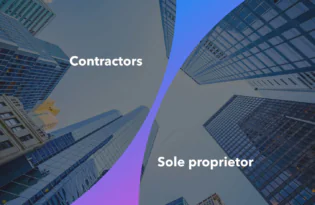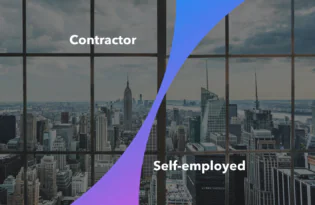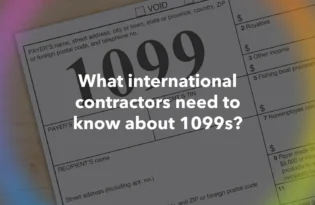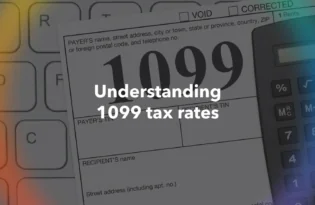1099 tax benefits & deductions
Want to get the most out of your 1099 tax benefits & deductions? We want to help. Our article breaks down the most common deductions and how to get them.

1099 contractors experience a double-edged sword when it comes to taxes; on one hand, they receive no benefits or protections for their work (other than what is provided in their contract), but on the other, they are able to claim and write off significantly more than their W-2 counterparts.
The following article explores this dichotomy; In addition to clearly delineating who is eligible for 1099 tax benefits & deductions, we outline those benefits according to both contractors as well as the businesses hiring them. Finally, we provide final words of advice and suggestions for those who are getting started.
What is the 1099 classification status?
1099 contractors are a classification of workers who represent themselves in their working relationship with a company, as opposed to an employee who works for them. The difference between the two can feel remarkably thin at times, but it is essential for understanding who is entitled to what benefits.
The table below provides a high-level overview:
| 1099 Contractor | W-2 Employee | |
|---|---|---|
| Definition | Self-employed worker who manages their own taxes and benefits | Employee of a company who withholds and manages benefits/taxes on their behalf |
| Benefits | None | Health, PTO, 401(k) |
| Withholding | Self-managed | Employer Withholds |
| Common Tax Rate | ~15.3% | Income tax only |
| Tax Forms | 1099-NEC, W9 | 1040, W-2 |
If you are unsure if you or a contractor you are considering hiring actually qualifies for 1099 status, we recommend using federally approved classification tests like the IRS 20-Point checklist or the Department of Labor’s (DOL) Economic Realities Test; either should be able to correctly indicate one way or the other.
What do I need to know as a contractor?
Contractors who are getting started with their 1099 should be aware that a great deal of their job qualifies as a write-off come tax season. It is highly encouraged that contractors take full advantage of these deductions in order to make up for the steeper rate at which they pay in (approx. 15%).
The table below provides an overview of contractor-facing 1099 benefits & deductions, as well as how to file for each.
Contractor-Facing 1099 Benefits & Deductions
| Deduction | What It Covers | Documentation Needed | How to Claim | Where to Apply |
|---|---|---|---|---|
| Home Office Expense | Exclusive workspace used regularly for business | Floorplan, utility bills, photos | Form 8829 or Schedule C | IRS Form 8829, attach to 1040 |
| Equipment & Software | Laptops, cameras, editing software, and subscriptions | Receipts, credit card statements | Line 27a, Schedule C | Schedule C |
| Health Insurance | Premiums paid for yourself, spouse, and dependents | Policy documents, 1095-A, or invoices | Line 17, Schedule 1 (Form 1040) | Schedule 1, attach to 1040 |
| Self-Employment Tax | 50% of SE tax | Self-employment tax worksheet | Schedule SE, Line 14 | Schedule SE |
| Travel & Meals | Business-related travel, lodging, and 50% of meal costs | Receipts, itinerary, client’s purpose | Line 24a & 24b, Schedule C | Schedule C |
| Education/ Training | Courses, certifications, industry-related learning | Course receipts, enrollment docs | Line 27a, Schedule C | Schedule C |
In addition to claiming deductions on your regular tax forms, contractors may choose to represent themselves as a legal entity, for example, setting up an LLC or S-Corp.
There are several hoops to jump through; however, successfully doing so entitles you to several additional benefits, such as:
- Legal protections from personal liability
- Deduction of ordinary & necessary expenses
- More flexible taxation rates, depending on whether you have an S-Corp
It should be noted that contractors considering these options have additional considerations to think about, such as hiring employees themselves and increased bookkeeping. As a general rule, these more advanced options should probably be held off until you are making a medium-to-high wage (~$80,000/yr) consistently.
What should businesses know about 1099 benefits & deductions?
While most 1099 benefits & deductions seemingly apply to the contractors themselves, the reality is that they also impact the business’s own deductions and legal obligations. Contractor payments themselves, for example, are a deductible business expense.
The following table provides an overview of business-facing 1099 benefits & deductions, including where and how to claim them.
1099 Benefits & Deductions for Businesses
| Expense / Deduction | What It Covers | Documentation Needed | How to Claim | Where to Apply |
|---|---|---|---|---|
| Contractor Payments | Fees paid to freelancers, consultants, or gig workers | Contracts, invoices, W-9s, 1099s | Line 11, Schedule C (or business return) | Schedule C, Form 1065, 1120, or 1120S |
| Software & Tools | Tools used to manage contractors | Receipts, software licenses | Line 18, Schedule C | Schedule C or corporate return |
| Office Supplies & Equipment | Tech or supplies used in managing or supporting contractors | Receipts, inventory logs | Line 22, Schedule C | Schedule C or corporate return |
| Independent Contractor Platforms | Costs to use portals | Platform invoices, payment logs | Line 27a, Schedule C | Schedule C |
| Training/Onboarding Materials | Manuals, videos, and materials to help contractors onboard | Content files, receipts | Line 27a, Schedule C | Schedule C |
| Legal & Professional Fees | Lawyer or accountant fees for contractor contracts/compliance | Invoices, engagement letters | Line 17, Schedule C | Schedule C or corporate return |
For businesses that hire and pay contractors regularly or who want to lower their overall tax liability, taking advantage of these deductions is a critical step in reducing their overall tax spend. When hiring and paying contractors, it is vital to:
- Maintain detailed income and expense records
- Make the most of tax-reporting tools
- Keep up with quarterly estimated tax payments to avoid IRS penalties
What are the red flags I should watch out for?
True to the nature of 1099 contracting, the great rewards possible are contrasted by the potential penalties that come with 1099 status. Contractors and the businesses that hire them face several fines and penalties for misclassification, underreporting, or over-deducting.
The following table contains a non-comprehensive list of the most common violations and their typical associated penalties:
| Potential Violation | Potential Penalty or Risk |
|---|---|
| Underreporting 1099 income | Up to 20% of tax owed |
| Missing quarterly estimated taxes | Up to 0.5%/mo |
| Misclassifying contractors as employees | Back taxes + fines |
| Excessive/unsubstantiated deductions | Audit risk + denial of deductions |
| Repeatedly showing business losses | IRS may refuse deductions, claiming it a hobby |
| Not issuing 1099-NEC to qualifying contractors | ~$60–$310 per form |
When in doubt, remember that the IRS is far less concerned about your money than they are about your receipts. Proper documentation is often the key to avoiding penalties while taking advantage of 1099 tax benefits & deductions.
Who should I ask for help?
For businesses and the contractors themselves alike, the prospect of managing their own taxes can be daunting. This often leads contractors to seek expert guidance, only to find an overwhelming amount of options in the current marketplace.
Among international payment portals, there are also seasoned tax professionals and software available for a more specialized or manual approach. The table below compares each overall, including suggestions for whom they are best suited:
Best Tax Tools for Handling 1099 Benefits & Deductions
| Tool/Pro | Pros | Cons | Best For |
|---|---|---|---|
| International Portals | Suitable for tracking global payments | Not tax-specific | Businesses hiring global freelancers; Freelancers looking for automated tools |
| Tracks contractor payouts | Limited reporting | ||
| Tax Professional | Personalized advice | Higher cost | High-income freelancers |
| Handles complexity | Time to schedule | ||
| Tax Software | Affordable & Fast | Can miss optimization or red flags | Solo contractors with straightforward tax needs |
| User-friendly | Limited Audit Support | ||
| IRS Free File | Free and accessible | Limited to simple returns | Low-income earners |
| Hosted by IRS | No guidance |
Managing contractors with Payoneer Workforce Management
Often, contractors and business owners get the most out of their 1099 tax benefits & deductions through a contractor management system.
These tools provide a suite of both contractor-facing and business owner-facing options to simplify compliance, including agent-of-record (AOR) services that allow business owners to streamline contractor management.
If you are interested in seeing how a comprehensive contractor management tool like Payoneer Workforce Management can support your business, book a demo today.
Disclaimer
- Skuad Pte Limited (a Payoneer group company) and its affiliates & subsidiaries provide EoR, AoR, and contractor management services.
- The information in this article/on this page is intended for marketing and informational purposes only and does not constitute legal, financial, tax, or professional advice in any context. Payoneer and Payoneer Workforce Management are not liable for the accuracy, or reliability of the information provided herein. Any opinions expressed are those of the individual author and may not reflect the views of Payoneer or Payoneer Workforce Management. All representations and warranties regarding the information presented are disclaimed. The information in this article/on this page reflects the details available at the time of publication. For the most up-to-date information, please consult a Payoneer Workforce Management representative or account executive.
- Availability of cards and other products is subject to customer’s eligibility. Not all products are available in all jurisdictions in the same manner. Nothing herein should be understood as solicitation outside the jurisdiction where Payoneer Inc. or its affiliates is licensed to engage in payment services, unless permitted by applicable laws. Depending on or your eligibility, you may be offered the Corporate Purchasing Mastercard, issued by First Century Bank, N.A., under a license by Mastercard® and provided to you by Payoneer Inc., or the Payoneer Business Premium Debit Mastercard®, issued and provided from Ireland by Payoneer Europe Limited under a license by Mastercard®.
Related resources
Latest articles
-
How to hire employees in Australia
Looking to hire employees in Australia for your US company? Learn about employment in Australia and how Payoneer Workforce Management makes it easy to hire in Australia.
-
Planning to hire employees in Germany? Here’s a quick guide
Looking to hire employees in Japan for your U.S. company? Learn about hiring practices in Japan and how Payoneer Workforce Management makes it easy to hire in Japan.
-
Planning to hire employees in the Philippines? Here’s a quick guide
Wondering how an American company hires employees in the Philippines? Our guide covers how to hire employees in the Philippines and how we can help.
-
Planning to hire employees in Japan? Here’s a quick guide
Looking to hire employees in Japan for your U.S. company? Learn about hiring practices in Japan and how Payoneer Workforce Management makes it easy to hire in Japan.
-
Planning to hire in Hong Kong? Here’s a quick guide
Are you hiring employees in Hong Kong for your U.S. company? Learn about employment in Hong Kong and how Payoneer Workforce Management makes it easy to hire in Hong Kong.
-
Planning to hire in Colombia? Here’s a quick guide
Looking to hire employees in Colombia for your U.S. company? Learn about employment in Colombia and how Payoneer Workforce Management makes it easy to hire in Colombia.















